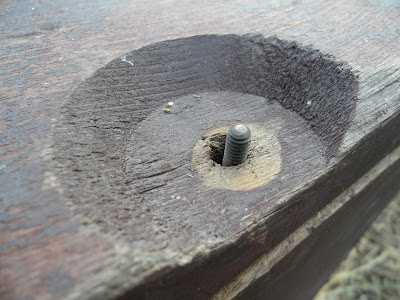The other day I stopped by our local used building supply store and spotted a couple of rare ammo boxes tucked in a corner. A metal ammo box, and larger, wooden ammo crate. Both rare and quite amazing. (I'll be showing the metal ammo box in the next posting).
The wooden crate is a rare, and unaltered, example of a "between the wars" ammo crate. This ammo crate still retains all of its original markings, stencils and components, with the exception of the securing wingnuts for the lid, and the sealing lid for the metal liner.
It is to be expected that the sealing lid would be missing, as it is a disposable component that is normally destroyed when it is pried off to remove the ammo. The wingnuts often fall by the wayside as well. The truly amazing thing is that this crate has survived without the usual alterations, scars and damage from civilian usage. This crate is quite literally, a time capsule. It appears exactly as did after it was opened and the ammo issued out, around 80 years ago!
 |
| Penguin The Cat gives the crate his seal of approval! |
This crate is marked as holding, 1500 rounds of M1 .30 cal. rifle ammo, boxed and in stripper clips. M1 .30 cal ammo was manufactured and issued from 1926 until 1941.
The M1 round was designed for use in the 1903 Springfield rifle and was also used in the early M1 Garand rifles. In 1941, M1 ammo production stopped, and the newer M2 round took its place.
The M1 Garand rifle was produced from 1936 until 1957, and the 1903 Springfield rifle saw use into the early WW2 years of the 1940's. So, the ammo in this box could have been used by either, or both, of these rifles.
Dating these old boxes is an interesting challenge. There is no issue date marked on them. We have to do a bit of detective work and research to narrow down the date.
On this box, I was extremely lucky to have the named military unit it was sent to, and the lot number of the ammo that was packed in it. These two bits of information were crucial in tracking down the main history of the box.
First off, let's cover the date of this crate, and how I figured that out.........
This crate is marked with the lot number of 1652. Although we don't have the exact date that this lot number was manufactured, we do have a couple of other lot numbers that have been confirmed with a date. Using these confirmed lot numbers, the date of this box has been narrowed down to the mid-1930's, very likely 1935 or 1936.
 |
| Lot F.A. 1652 (F.A. stands for Frankford Arsenal) |
For those of you interested in how this was done, here's the "math".
Known lot numbers and dates:
1926 Lot # 671 (published and known starting lot number for M1 ammo)
1937 Lot # 2007 (confirmed production date-lot number from a collectors unfired ammo)
1941 Lot # 2161 (published and known last lot number for M1 ammo)
Since the lot number of my ammo crate, 1652, it falls between 1926 and 1937. I computed the average number of lot numbers produced for each year between those dates, and compared it to my lot number. This placed my lot number, 1652, in 1935 or 1936. With that information, we have a very rough estimate of the year for this ammo crate. Since we do not know if ammo production was steady and consistent, for every year of production, the actual age of the crate may shift up or down a bit, but not later than 1937.
So now we have the date, "1936". Now let's see who this ammo was issued to.
The crate is addressed from:
Benicia Arsenal
To:
C.O. (Commanding Officer) Troop B
116th Cavalry, IDG (Idaho National Guard)
Pocatello, Idaho
Having the actual unit that the ammo was sent to, really opens up the history of this box.
First let's address the unit this crate was sent to.
The 116th Cavalry, Idaho National Guard, was based in Pocatello, Idaho until it was disbanded in 1940. It was a component of the 24th Cavalry Division. The 116th was a mounted cavalry unit and the mention of "Troop B", confirms this as well. The "Troop" designator was only used with mounted units.
In 1940, the 116th Cavalry regiment, as well as the 24th Cavalry Division, disbanded and turned in all of their horses. The 116th unit number was then reassigned to a newly formed artillery unit. It was the end of the US Cavalry Era.
From what I can tell from my research, the 24th division and 116th Regiment were extremely active on field maneuvers during the mid to late 1930's. This ammo crate falls into that time period.
This ammo crate was sent from the Benicia Arsenal. This arsenal was the primary arsenal for the entire West Coast from 1851-1964. It was located in Benica, California, in the San Francisco Bay Area. The arsenal was deactivated in 1963, and closed in 1964.
The ammo that was originally in the crate, was manufactured at the Frankford Arsenal in Philadelphia, Pennsylvania. This was an active ammunition facility from 1816-1977.
One of the amazing features of this ammo crate is that the original seal from the Frankford Arsenal is still present!
These ammo crates were originally sealed with the top wing nuts, then a metal staple was applied on the lid-to-side overlap, in the recessed seal area. A paper seal from the issuing arsenal was then glued over the staple. This crate has most of the original seal intact, and it appears that the original sealing metal staple was removed very carefully, with no damage to the crate"
The top of the crate was secured with stamped sheet metal type, wing nuts. These nuts threaded onto a stud that was fixed into a groove inside the lower crate. The lid is recessed in the area that the nuts screwed down. This crate shows the bare-wood outline of two of the original wing nuts, indicating that the crate was painted after the lid was sealed with the wing nuts, but before it was sealed with the paper arsenal seal (painted under the paper seal). All of the studs are intact and the lid does not show any damage from removal.
The crate is lined with a removable, tin ammo box. This inner, tin box, would have held the packaged ammunition and was originally sealed with a soldered-on, tin lid. The lid was peeled back to expose the ammunition when it was issued, and then discarded. It is quite amazing to see that the sealing lid was very carefully removed without damaging the rest of the tin liner. This is quite rare for these old crates!
 |
| The tin liner is painted with a tar-like preservative. |
With the metal liner removed, I found what appears to be original sawdust from the manufacture of the crate! This would seem to indicate that the metal liner has remained in place since it was installed with the original ammunition. Very unique and amazing.
With the liner removed, you can also see quite easily how the top securing studs are mounted.
This is an amazing well preserved "time capsule" from the end of the Golden Age of the US Mounted Cavalry. It is unique in nearly every aspect, from the time period it was manufactured, the ammo it held, the unit that it was sent to, as well as the arsenals that packaged and dispersed it. But most remarkable of all is the fact that it has survived in virtually original and unaltered condition to today.
It now has an honored spot in my collection. Saved from a questionable fate at a "Used Building Supply" store!
To finish things up, here is an album showing some more details of this amazing ammo crate.
 |
| "Troop B" is written on the underside of the lid, in pencil, in "old style" handwriting. |
 |
| Very nice "Ordinance Bombshell" stencils on both ends. |























































